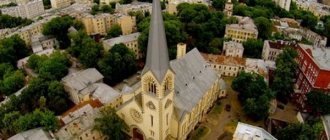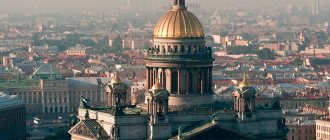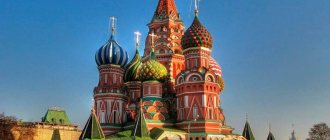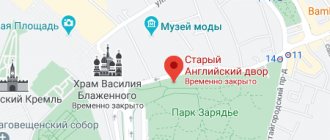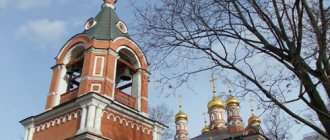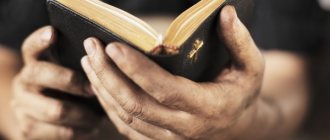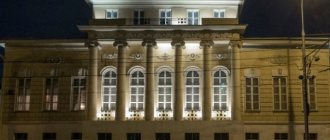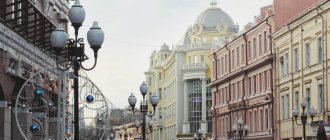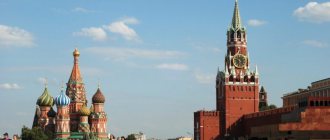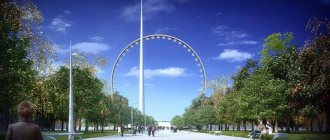Kolomenskoye Park photo in spring
On one of the sunny days in May, and it was a Sunday in mid-May, we visited Kolomenskoye Park. It always, at any time of the year, attracts residents and guests of the capital, and in the spring, when all nature comes to life and blooms, it is even more beautiful and interesting here. I invite you, dear reader, to take a walk through Kolomenskoye Park.
The content of the article
Kolomenskoye Park is located near the metro station of the same name. Together with everyone else we go up the park alley. It is very beautiful, there is fresh spring greenery all around, tulips are blooming, fragrant lilacs are fragrant.
At the Spassky Gate there is a large flower bed of tulips, of different colors and shades:
“The Original Palace” - House of Peter I in St. Petersburg
House of Peter I on Petrovskaya Embankment in St. Petersburg. Photo: Andrea Rudi / photobank “Lori”
The “original palace” or “Red mansions” was the name given to a small wooden house erected by order of Peter I at the end of May 1703. It became the first building of the new Russian capital - St. Petersburg.
The Swedish-style house was built from pine boards painted to resemble brick. The roof was decorated with images of mortars and cannonballs. This meant that the “captain of the bombardment company” lived here - under this rank the emperor was included in the army lists. The inside walls were covered with canvas, the door jambs and window frames were decorated with “grass” painting - a floral design on a black background. In the middle of the building there was a vestibule, on either side there was an office, a dining room and a bedroom.
In 1723, Peter ordered to surround the “Primary Palace” with a protective gallery. Its design was developed by the architect Domenico Trezzini. During the reign of Peter I's daughter, Empress Elizabeth, the house was converted into a chapel, where the relic of the Romanov family was kept - the icon of the Savior Not Made by Hands. Now this image is in the Transfiguration Cathedral of St. Petersburg.
In the mid-19th century, a brick “case” was erected around the wooden building to protect it from the effects of time. The plot of land adjacent to the “Primary Palace” was fenced with cast-iron bars and a garden was laid out on it. Since 1930, the House of Peter I belonged to the Peterhof complex, and in 2004 it became part of the Russian Museum.
Now the interior of the 18th century has been restored in Peter's House. The exhibition includes some things that belonged to the emperor - a cloth uniform, a cane made by oriental craftsmen, an armchair, and a small rope boat. A cast iron copy of Peter’s hand, created in 1707 by Lipetsk craftsmen, is also kept here.
Kazan Church
The linden alley, which begins immediately outside the park gates, leads to the Church of the Kazan Icon of the Mother of God, 1651-1671.
The temple is operational, the first throne is dedicated to the Kazan Icon of the Mother of God, it was considered the main shrine of the militia of D. M. Pozharsky and K. M. Minin, who liberated Moscow from the Poles in 1612, after which the Kazan Icon of the Mother of God became one of the main shrines of the Muscovite kingdom of the 17th century. The second altar of the palace church is dedicated to Saint Averky of Hieropolis, whose memory is also celebrated on the day of the liberation of Moscow from the Poles on November 4.
Turning to the right from Linden Alley, we approach Peter’s House.
House-Museum of Peter I in Vologda
House-Museum of Peter I in Vologda. Photo: stargal / photobank “Lori”
The house-museum of Peter I in Vologda - otherwise known as “Petrovsky House” - served as the residence of the emperor and his wife during visits to the city. It is known that Peter stayed here at least five times.
The stone one-story house, built in the 17th century, previously belonged to the Goatman family of Dutch merchants. Art critic Georgy Lukomsky described this building as follows: “... the courtyard of the Dutchman Goutman belonged to the best township places in the city, recommending the owner as a very wealthy man, who had a stone chamber with three dwellings and in a relatively small courtyard area there were up to nine residential premises, and In addition, there is a trading shop.”
After Peter's death, the house in Vologda remained abandoned for a long time. It was restored only in 1875. Now the Museum of Peter I is located here. On the façade of the building there is an ancient stone plaque with a coat of arms - a hand holding an axe. The museum houses about 100 exhibits. Among them are the camisoles of Peter I, a cup that belonged to Alexander Menshikov, antique chairs with the Dutch coat of arms on the backs, and soldier’s camp flasks decorated with engraving.
House of Peter 1 in Kolomenskoye
There are many foreign tourists in the park of the Kolomenskoye Reserve Museum - on Lipovaya Alley, at the Kazan Church of Our Lady and at Peter’s House there are tourists from China:
Peter's house 1 story. Peter's house was built in May 1702 at the mouth of the Northern Dvina on the island where the tsar stayed during the construction of the Novodvinsk fortress, which protected Arkhangelsk from the Swedes.
In 1934, the house was transported to Moscow, to Kolomenskoye. In accordance with the surviving descriptions of the house in which Peter 1 lived, the office, vestibule, dining room, resting room, orderly and closet were recreated. Typical objects of that time from the museum’s collections convey the spirit of the era and allow one to realistically imagine this historical time.
Bedchamber
This is the back room in the house, intended for relaxation. Peter was accustomed to living in small rooms since childhood, even when he lived in the Kolomna mansions of the palace of Tsar Alexei Mikhailovich. In the red corner of the resting room there is an icon depicting the Holy Trinity; Peter 1 never parted with this icon.
The walls are covered with scarlet cloth, which served to decorate the chambers and retain heat. The chambers were illuminated by table candlesticks.
Look at more photos of Peter's House 1. In the entryway there are portraits and preserved objects of that historical time:
Cabinet
Located in the center of the house. Geographic maps, books on military and naval affairs, a model of a sailing ship, and drawing tools characterize the interests and hobbies of the Tsar and convey the spirit of Peter’s personality: a builder, a swimmer, a hero, a great reformer of Russia.
Dining Chamber
The interior of the dining room was restored taking into account the documents of Peter's stay in the Novodvinsk fortress. On June 29, 1702, on the day of the apostles Peter and Paul, the Tsar celebrated his name day in Arkhangelsk. The table was richly set, the wine was in forty barrels and tubs, and they walked for 3 days.
In the red corner of the dining room there is an icon of Christ the Savior, traditional for the Russian house. The rooms of the house were heated by tiled stoves.
Connected to the bedchamber was the orderly's room for the king's servants:
After visiting Peter's House in Kolomenskoye, we will continue our walk through the park.
The one who is first
On the eve of the 350th anniversary of Peter I, the project “Peter. First. Collector. Researcher. Artist", which is attended by the Green Vaults Museum (Dresden), the Amsterdam History Museum, the National Maritime Museum (Greenwich), the State Hermitage, the Naval Museum (St. Petersburg), the Kunstkamera, the Kuskovo Estate Museum, Russian archives and libraries...
Curator Olga Vladimirovna Dmitrieva tells RG about the exhibition, which opens the day after tomorrow.
Peter I, who opened a window to Europe, is remembered as the builder of the fleet, the creator of the new capital on the Neva and the winner of the Battle of Poltava... The exhibition dedicated to his interests as a collector looks somewhat unexpected. Is it possible to talk about Peter’s personal choice as a collector?
Olga Dmitrieva: Of course. During the “Great Embassy” of 1697-1698, Peter saw various “Cabinets of Wonders”, or cabinets of curiosities, in Amsterdam, London, Dresden, and Vienna. It was during this period that they acquired a new look. From a random selection of rare wonders and exotic plants and animals, they turn into natural science collections. Their collectors are trying to systematize acquisitions, to separate fantastic stories about their origin from facts... In a word, cabinets of curiosities become a tool for understanding the world. And Peter not only “amazes at the miracle,” but learns very quickly and adopts experience.
Do you mean creating a Kunstkamera modeled on the Dutch “cabinets of wonders”?
Olga Dmitrieva: The Kunstkamera in St. Petersburg appeared later. And first he acquires for himself the most famous natural science collections in Europe. Peter bought the collection of Frederick Ruysch, the famous anatomist and physician, whose classes he attended. In the same way, he bought the famous collection of stuffed animals, birds, and fish that belonged to the Amsterdam pharmacist Albert Seba. His collections were wonderfully cataloged, and we will have a huge catalog of these natural wonders from Seb's office on display at the exhibition.
Peter corresponds with them. For example, he sends samples of some insects from Russia to Ruyshu in exchange for similar samples from India, the East Indies, and the West Indies. In other words, he behaves like a real collector. Later these collections will become the basis of the Kunstkamera.
Is Peter doing this himself?
Olga Dmitrieva: Of course. He is extremely passionate about this. Later, when showing guests the collections of the Kunstkamera, he was very fond of giving comments himself. He viewed this museum as exploratory, universal, and encyclopedic. Moreover, this museum will become the core of the Academy of Sciences.
But it’s unlikely that the collection was conceived as the basis of the Academy of Sciences?
Olga Dmitrieva: It is impossible to document this. But in London he met the Royal Scientific Society, which was patronized by the English monarchs - in 1662 the Royal Society received a Charter from King Charles II Stuart. He visited the Royal Observatory in Greenwich on several occasions. Later, Peter carefully studied the structure of the French Academy of Sciences, of which he was elected a member in 1718. Most likely, the idea of creating an Academy of Sciences in Russia came to him very early, around the same years 1697-1698.
At the exhibition we will show two extremely rare autographs. One is a letter from Isaac Newton, in which he congratulated His Serene Highness Prince Menshikov on the occasion of his election in 1714 as the first Russian member of the English Royal Society. This is Newton's only autograph in Russia. The second is a report by the German scientist and philosopher Gottfried Wilhelm Leibniz, who entered the service of Peter I and proposed his projects for building the Academy of Sciences. Thus, he believed that the core of the Academy of Sciences should be the Botanical Garden, the Anatomical Theater, the library and museum, and, of course, the university.
Was the museum not considered by Peter as a source of income?
Olga Dmitrieva: When one of the nobles suggested that Peter take money for a visit to the Kunstkamera, Peter replied that this would be extremely short-sighted. Andrei Nartov, Peter’s closest associate, writes about this.
But still, buying ready-made collections is not the same as being a collector in the full sense.
Olga Dmitrieva: Why not? Peter is the first Russian collector who was completely conscious of the preservation of cultural heritage.
... what didn’t stop the boyars from shaving their beards?
Olga Dmitrieva: Well, firstly, it hardly makes sense to consider the beards of the boyars as cultural heritage. And, secondly, it was Peter’s interest in modernity that gave rise to interest in antiquities.
How?
Olga Dmitrieva: We will have an interesting section at the exhibition dedicated to Peter’s Siberian collection. It allows you to trace how this mechanism worked. The fact is that in Amsterdam, Nicholas Witsen, burgomaster, wealthy merchant and owner of a substantial “collection of miracles,” showed Peter antiquities from Siberian mounds. Gold items from ruined Scythian mounds have already appeared on the antique market in Europe. Witsen decorated his two-volume publication about “Tartary” with drawings with their images, that is, about Tatary and Eastern Siberia. Peter realized that these rarities were mined in his lands.
As a result, in 1716, he issued an order to the governor of Siberia: if such works of art are found, then they must be bought back at a fair price and sent to St. Petersburg, to the treasury. The king himself looked at the finds and selected the most interesting for his collection. Grave diggers were ordered to be punished severely, including execution. In fact, these decrees of Peter can be considered the first legal act on the protection of cultural heritage.
Moreover, the king also orders to sketch the locations of the finds. And then he sends Daniel Gottlieb Messerschmidt with an expedition to excavate a mound near Abakan. This is the first archaeological expedition. In other words, Peter lays the foundations of Russian archeology and ethnography. This is the consequence of a sincere youthful fascination with the “curiosities” of the cabinets of curiosities.
It turns out that the protection of cultural heritage is a sign of the modern era? Is it changes in the present that awaken interest in the past?
Olga Dmitrieva: In any case, having discovered in Europe that antiquities were an object of interest for scientists and collectors, Peter was, apparently, the first of the Russian sovereigns who began to realize that past eras were marked by different styles. Having seen collections of antiquities and ancient arts in the West, he begins to order his agents to purchase Greek and Roman antiquities - from sculptures to coins, gems and intaglios. Peter begins to understand what a monarch's collection should be so that it strengthens his prestige as an enlightened ruler. Hence the appearance of not only the Tauride Venus in the Summer Garden, but also the beginning of collections of Flemish and Dutch painting. The first Rembrandt painting was bought to Russia precisely on Peter’s instructions.
Alexander Benois spoke rather skeptically about Peter’s collections of paintings, noting that the Tsar was indifferent to painting.
Olga Dmitrieva: This is a common statement. But it is not supported by anything. Probably everyone is relying on the words of Thomas Macaulay that Peter was more interested in the construction of some kind of weather vane than in the gallery of old masters in Kensington Palace. But it is quite difficult to judge Peter’s picturesque impressions. There are no emotional notes on this topic in the travel journal. We must judge by deeds. Let's see what he does after his first trip.
At shipyards in Holland, he meets draftsmen who were also artists and engravers. Meets Adam Silo, who will become one of his favorite marine painters. We see paintings by Silo in Monplaisir and other palaces of Peter. Subsequently, when the tsar spoke about his favorite artists, he, according to the memoirs of Jacob Stehlin, named Bruegel, Rubens, Van Dyck, Adrian van Ostade. He sees the paintings of all these artists in the first “embassy”.
Not a bad choice...
Olga Dmitrieva: Not only that. After the first trip, Peter begins to learn the art of engraving from Adrian Schonebeck, a famous engraver. At the exhibition you can see a handwritten textbook on engraving, which Schonebeck wrote especially for him. By the way, this is the first Dutch treatise on the art of engraving in general. A little later, Schonebeck and his relative Peter Picart would come to Russia and become the founders of the Russian school of engraving. All the famous engravers of the Peter the Great era went through their school.
Finally, Peter perfectly understands how painting can be used to shape his image as a European monarch. In Holland he poses for a ceremonial portrait for three or four artists. Including Gottfrey Neller, who depicts young Peter in knightly armor, a royal robe... And in England, Peter also ordered several dozen miniature portraits from the Swedish miniaturist, which he distributed as awards and memorable gifts.
Why did you decide to show works from museums in Amsterdam, Dresden, and Greenwich at the exhibition? What do they have to do with Peter's collections?
Olga Dmitrieva: We focused on the collections that he saw on his first trip. Along with the Green Vaults in Dresden, this is, of course, the Hofburg in Vienna, the palaces and art collections of William III of Orange in England and Holland...
The collection of the "Green Vaults", the famous treasury of the Saxon electors, enjoyed pan-European fame. And for Peter, the intention of Augustus the Strong, Elector of Saxony and King of Poland, his friend and ally, to turn it into a museum open to the public was an inspiring example.
Peter not only begins to think about displaying the most important monuments and royal regalia, he arranges a “Sveisky”, that is, Swedish, hall in the Kremlin, where he displays trophies taken in the battle of Poltava. In other words, he begins to place things in the Kremlin Armory that were not so much treasures as evidence of his victories.
We will show the masquerade dress of Catherine I, in which she danced at the ball in honor of the Peace of Nystadt. This masquerade, like the triumphal processions, was part of the celebrations dedicated to the victory in the Northern War. It is clear that the Amazon costume of Catherine I is by no means coronation clothes. But by personal decree, Peter sends this dress to the Armory to preserve it as a memory of the celebration in honor of victory and peace.
We see how he rethinks the role of the golden storehouse of the royal dynasty. He opens its doors, expands the range of things presented, turns it into a stage of history and historical memory of the state.
...becomes the founder of the museum business?
Olga Dmitrieva: Without a doubt. It is enough to mention that at the end of his life he issued a decree that every object entering the Kunstkamera be carefully sketched. For this reason he founded the Drawing and Engraving Chambers at the Academy of Sciences. Thanks to their drawings, we have an idea of the things that were lost during the fires. In particular, at the exhibition we will show drawings of Chinese objects that come from the collection of James Bruce, a companion of Peter. Bruce, like Peter, by the way, turned out to be a big fan of Chinese art.
Is the lathe promised at the exhibition just from the Engraving Chamber?
Olga Dmitrieva: No. This is the machine that Peter, who was a skilled draftsman, worked on. He could compose a complex composition or make a sketch of a portrait, and then cut them out - on metal, bone or wood. In the exhibition we show an engraving created by him - an allegorical composition on the theme of the triumph of the Christian faith.
Isn’t the definition of “artist” in the title of the exhibition a metaphor?
Olga Dmitrieva: No. Everything is accurate. Peter was a colossally gifted person.
*This is an expanded version of the text published in the issue of “RG”
Front yard gate
Front gate of the Sovereign's courtyard, 1672-1673. - this was the main entrance to the territory of the Sovereign’s courtyard:
Through the Front (Red) Gate we get to Voznesenskaya Square - read more about the history and memorable places of Kolomenskoye in this article .
Here are the Church of the Ascension, 1532 - a UNESCO World Heritage Site, the Bell Tower - the first half of the 16th century and the Church of St. George, 1841.
We go down the wide stairs to the Moscow River and Golosov Ravine. Bird cherry and hawthorn bloom on both sides:
Embankment of the Moscow River
Let's take a walk along the Kolomenskaya embankment of the Moscow River, here the river makes a turn:
Motor ships approach the Kolomenskoye pier; you can take a boat ride along the Moscow River. Look at this handsome snow-white motor ship sailing past and looking at its mirror reflection in the water:
Wild ducks swim on the river, many seagulls fly over the water. By the water you can take a wonderful break from the heat in the shade of the trees, there are benches here, or you can just sit on the grass, the water and nature are soothing.
Not far from the Kolomenskoye pier, a little higher up Zhuzha Street, there is the Dutch House of Tsar Peter 1, donated to Russia by the Dutch government in 2013 as part of the year of Russian-Dutch cooperation. The house retains its original dimensions, the exhibition reproduces the interior of the house of Peter I in Zaandam (Netherlands).
